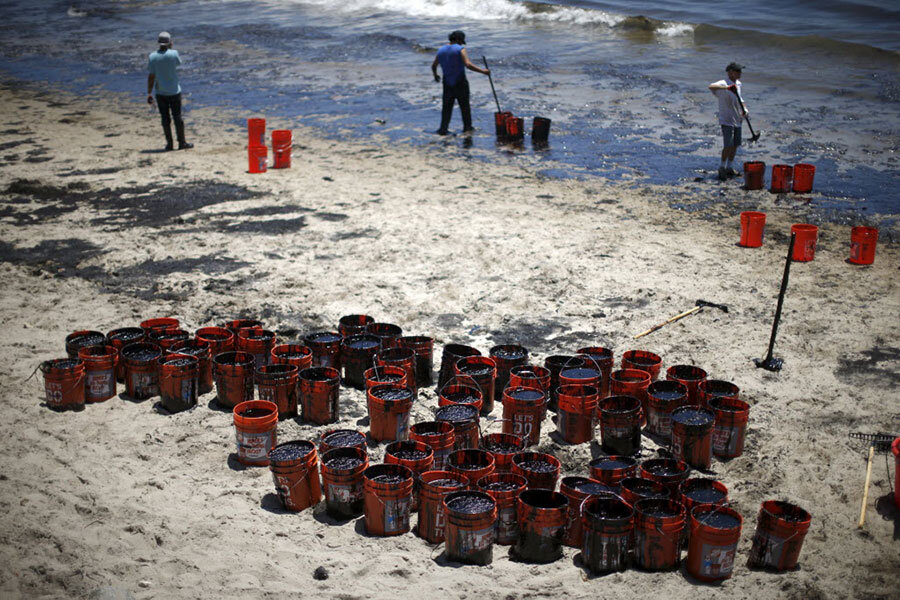Santa Barbara oil spill raises questions about California pipelines
Loading...
| Los Angeles
Environmental groups are pointing to an oil spill near Santa Barbara, Calif., to highlight what they say are the dangers of expanding tar sands oil production 10-fold during the next decade, which would result in transporting large volumes of oil along the California coast.
Federal, state, and local agencies will be investigating the Santa Barbara spill, which has been estimated at as much as 105,000 gallons, checking details such as why an automatic shutoff valve did not deploy.
The spill puts the pipeline's parent company, Plains All American Pipeline, in the spotlight. The company transports and stores crude oil all over North America, netting $1.39 billion in revenue last year.
“Plains deeply regrets this release has occurred and is making every effort to limit its environmental impact,” the company said in a statement.
While the Santa Barbara crude oil spilled is not from tar sands, much of the transport of tar sands would be via pipelines like Plains All American Line 63, which ruptured Tuesday, according to the Natural Resources Defense Council.
“What we are seeing with this spill highlights the risks of this new expansion,” says Anthony Swift, an NRDC staff attorney, suggesting that tar sand oil is the most devastating to the environment.
About half of the new tar-sand oil development – some 800,000 barrels per day – would be destined for refineries in Washington State and California, according to an April 2015 report released by the NRDC and 29 other environmental organizations. The West Coast is far closer to the Canadian tar sands of Alberta than the Gulf Coast.
The pipeline that broke near Santa Barbara Tuesday reportedly carries 45,000 to 50,000 barrels of oil a day.
Three, 65-foot vessels, six cleanup boats with booms, and 73 people from the California Environmental Protection Agency, the United States Coast Guard, and the US Fish and Wildlife Service have been scrambling for two days to contain the spill and strip the crude from beaches, according to Alexia Retallack, a spokeswoman for the California Department of Fish and Game. They are focusing on habitat of snowy egrets and least terns.
Ms. Retallack encourages volunteers to check Cal Spill Watch on Twitter and Facebook for related announcements.
Santa Barbara was famously the site of a 1969 offshore oil spill credited with jump-starting the US environmental movement.
“I am deeply saddened by the images coming from the scene,” Rep. Lois Capps (D) of California said in a statement Wednesday morning. “This incident is yet another stark reminder of the serious risks to our environment and economy that come from drilling for oil.”
Among the issues are whether Plains All American or the state fire marshal has jurisdiction, the age of the pipes, and why the leak didn’t trigger an automatic shutoff valve. The pipe is equipped to detect small changes in pressure, Kevin Drude of Santa Barbara County’s Energy Division told the Santa Barbara Independent.
“It’s shocking that it took the company three hours to shut the pipeline down after it was reported by the public,” says NRDC’s Swift.
The Independent reports that such incidents are on the rise. The EPA recorded at least 10 serious incidents in Oklahoma, Texas, Kansas, and Louisiana since 2004.
It is too early to tell if there are any similarities to the 2010 Kalamazoo River oil spill, one of the costliest in US history, says Bruce Bullock, director of the Maguire Energy Institute at the Cox School of Business at Southern Methodist University in Dallas. That city is still struggling to cope, despite $1 billion in cleanup costs.
But Santa Barbara is better prepared, he adds.
“In Santa Barbara, there is an energy industry and Coast Guard presence readily available with the experience and technology to address incidents of this nature, unlike Kalamazoo.”
Moreover, pipelines have the safest record of any kind of oil transport, he adds.
"Pipelines have between 20 and 25 accidents per billion barrels of crude oil transported in a given year. Rail cars have over 10 times that accident rate per billion barrels transported,” he says.





